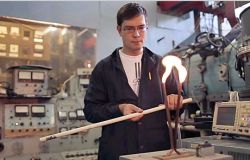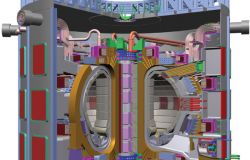Новости науки27 янв. 2016
НИЯУ МИФИ предложил уникальный способ удаления металлической пыли из термоядерных установокНа кафедре «Физики плазмы» НИЯУ МИФИ разработан способ удаления металлической пыли из термоядерных установок с помощью электростатических зондов. Подробнее...
20 янв. 2016
Статус государственного научного центра подтвердили семь организации «Росатома»16 янв. 2016
Андрей Гейм: графен может использоваться для очистки ядерных отходов 5 янв. 2016
Владимир Фортов. Интервью на "России 24". Эфир от 26.12.2015Насколько оправдывает себя реформа Академии наук? 10 дек. 2015
The first plasma in Wendelstein 7-X.10th December 2015: The first plasma in Wendelstein 7-X. It consisted of helium and reached a temperature of about one million degrees Celsius. (coloured black-and-white photo). On 10th December 2015 the first helium plasma was produced in the Wendelstein 7-X fusion device at the Max Planck Institute for Plasma Physics (IPP) in Greifswald. After more than a year of technical preparations and tests, experimental operation has now commenced according to plan. Wendelstein 7-X, the world’s largest stellarator-type fusion device, will investigate the suitability of this type of device for a power station. http://www.ipp.mpg.de/3984226/12_15
22 мая 2015
A little drop will do it: Tiny grains of lithium can dramatically improve the performance of fusion plasmasLeft: DIII-D tokamak. Right: Cross-section of plasma in which lithium has turned the emitted light green. (Credits: Left, General Atomics / Right, Steve Allen, Lawrence Livermore National Laboratory)
Scientists from General Atomics and the U.S. Department of Energy's (DOE) Princeton Plasma Physics Laboratory (PPPL) have discovered a phenomenon that helps them to improve fusion plasmas, a finding that may quicken the development of fusion energy. Together with a team of researchers from across the United States, the scientists found that when they injected tiny grains of lithium into a plasma undergoing a particular kind of turbulence then, under the right conditions, the temperature and pressure rose dramatically. High heat and pressure are crucial to fusion, a process in which atomic nuclei – or ions – smash together and release energy — making even a brief rise in pressure of great importance for the development of fusion energy. ... |
| Кафедра №21 | Кафедра № 37 | Кафедра №69 | Кафедра №87 | Кафедра №70 | Лаборатория №377 |
|---|
ЦЕНТР ПЛАЗМЕННЫХ, ЛАЗЕРНЫХ ИССЛЕДОВАНИЙ И ТЕХНОЛОГИЙ
г. Москва, Каширское шоссе, д. 31
Телефоны: +7 (495) 324-7024, +7 (495) 788-5699,
E-mail: plit@mephi.ru







